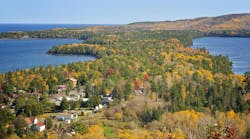Wetlands Work: Engaging Private Landowners in Wetland Restoration
About the author:
Megan Ossmann is an environmental management staffer for the Habitat Goal Implementation Team at the Chesapeake Bay Program Office. Ossmann can be reached at [email protected].
The Chesapeake Bay Program (CBP) is a regional multi-state and federal partnership that uses adaptive management of natural resources to meet restoration goals across the 64,000 square-mile Chesapeake Bay watershed. In 2014, representatives from the six watershed states (Maryland, Virginia, West Virginia, Delaware, Pennsylvania and New York) and the District of Columbia signed the Chesapeake Bay Watershed Agreement, which consists of 10 overarching goals and 31 outcomes, or targets, that will advance the restoration and protection of the Bay watershed.
One of those goals includes the Wetlands Outcome, which is to “continually increase the capacity of wetlands to provide water quality and habitat benefits throughout the watershed.” The major target of this outcome is to create or reestablish 85,000 acres of tidal and non-tidal wetlands and enhance function of an additional 150,000 acres of degraded wetlands by 2025 through voluntary restoration projects. The Bay Program partnership recognizes that most of these restoration projects will occur on agricultural lands, due to the landscape, historical presence of wetland areas and their impact on water quality. Approximately 50% of the wetlands in the watershed have been lost due to development and other changes in land use. Of these, one million acres have the potential to be restored, the majority of which are on agricultural land. Additionally, though agricultural land only comprises about 20% of the watershed, it is the source of about 75% of the nitrogen loading in the Chesapeake Bay. Restoring a small portion of these lands would help meet the Wetlands Outcome, as well as help meet additional goals of water quality, habitat and other watershed benefits.
The biggest challenge in achieving the Wetlands Outcome is convincing landowners to enroll in wetlands programs and install a restored wetland on their property. In 2015, the Wetland Workgroup, in partnership with The Nature Conservancy, The Chesapeake Bay Trust, Ducks Unlimited, the National Fish and Wildlife Foundation and OpinionWorks LLC, conducted research on landowner attitudes towards wetland restoration. Through a survey and targeted focus groups, the research identified barriers that prevent landowners from participating in wetland restoration programs, opportunities to improve landowner participation in restoration programs, and techniques that would improve outreach to landowners. One of the largest barriers that was identified was a lack of awareness of wetlands-specific programs – 40% of those surveyed were not aware of the existence of programs that help landowners restore wetlands on their property. However, 31% of landowners said that they would be very interested in participating in a program to restore a wetland on their property. To address this barrier, the researchers identified the need for increased outreach to landowners and information on the full suite of restoration programs available to be able to match landowners with a program that meets their goals. This would help move landowners from being generally interested to completing a restoration project.
Using these recommendations, in 2018 the Chesapeake Bay Program Wetland Workgroup and Web Team worked with Green Fin Studio to develop the Wetlands Work website. Wetlands Work encourages landowners in the Chesapeake Bay watershed to restore wetlands on their property, which will in turn accelerate the Chesapeake Bay Program’s progress toward its restoration goal. By entering their county and zip code, landowners are provided with a list of available funding programs and the contact information of local wetland planners who can help them develop a project on their property. This directory is available for all six states in the watershed. The website also provides basic information about the different types of wetlands, the environmental and economic benefits of wetlands, and the importance of restoration. In addition, the website walks through the five steps of building or restoring a wetland and provides resources and advice at each step: finding technical support; finding funding; applying for funding and designing the wetland; building the wetland; and maintaining the wetland.
Chesapeake Bay Program staff continuously manage the site by adding new programs and providers to the directory as they become available, interviewing landowners and adding success stories, and monitoring traffic on the site through analytics. Since the site launched in November 2018, the number of monthly users has steadily increased. The average number of monthly page views has tripled since this time last year. Most users find the site through an organic search, followed by a direct search, a referral from another site, or through social media. A few questions are also submitted to the site each month, which staff answer directly.
Wetlands Work helps to fill the knowledge gap about wetland restoration among landowners. This website acts as a resource for anyone who is interested in restoring wetlands on their property, and provides guidance on the steps, available funding, and local technical service providers who can help. Though this site specifically focuses on the Chesapeake Bay watershed, it can be used as a model for other organizations with similar goals for wetland restoration in need of information-sharing resources.


